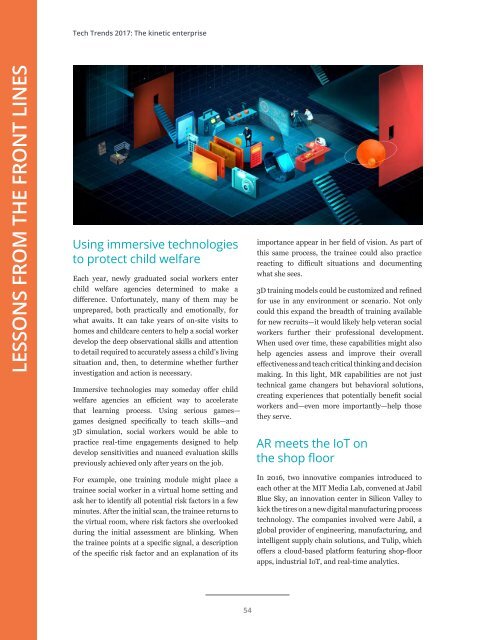Trending the trends Eight years of research
2kcf8xh
2kcf8xh
Create successful ePaper yourself
Turn your PDF publications into a flip-book with our unique Google optimized e-Paper software.
Tech Trends 2017: The kinetic enterprise<br />
LESSONS FROM THE FRONT LINES<br />
Using immersive technologies<br />
to protect child welfare<br />
Each year, newly graduated social workers enter<br />
child welfare agencies determined to make a<br />
difference. Unfortunately, many <strong>of</strong> <strong>the</strong>m may be<br />
unprepared, both practically and emotionally, for<br />
what awaits. It can take <strong>years</strong> <strong>of</strong> on-site visits to<br />
homes and childcare centers to help a social worker<br />
develop <strong>the</strong> deep observational skills and attention<br />
to detail required to accurately assess a child’s living<br />
situation and, <strong>the</strong>n, to determine whe<strong>the</strong>r fur<strong>the</strong>r<br />
investigation and action is necessary.<br />
Immersive technologies may someday <strong>of</strong>fer child<br />
welfare agencies an efficient way to accelerate<br />
that learning process. Using serious games—<br />
games designed specifically to teach skills—and<br />
3D simulation, social workers would be able to<br />
practice real-time engagements designed to help<br />
develop sensitivities and nuanced evaluation skills<br />
previously achieved only after <strong>years</strong> on <strong>the</strong> job.<br />
importance appear in her field <strong>of</strong> vision. As part <strong>of</strong><br />
this same process, <strong>the</strong> trainee could also practice<br />
reacting to difficult situations and documenting<br />
what she sees.<br />
3D training models could be customized and refined<br />
for use in any environment or scenario. Not only<br />
could this expand <strong>the</strong> breadth <strong>of</strong> training available<br />
for new recruits—it would likely help veteran social<br />
workers fur<strong>the</strong>r <strong>the</strong>ir pr<strong>of</strong>essional development.<br />
When used over time, <strong>the</strong>se capabilities might also<br />
help agencies assess and improve <strong>the</strong>ir overall<br />
effectiveness and teach critical thinking and decision<br />
making. In this light, MR capabilities are not just<br />
technical game changers but behavioral solutions,<br />
creating experiences that potentially benefit social<br />
workers and—even more importantly—help those<br />
<strong>the</strong>y serve.<br />
AR meets <strong>the</strong> IoT on<br />
<strong>the</strong> shop floor<br />
For example, one training module might place a<br />
trainee social worker in a virtual home setting and<br />
ask her to identify all potential risk factors in a few<br />
minutes. After <strong>the</strong> initial scan, <strong>the</strong> trainee returns to<br />
<strong>the</strong> virtual room, where risk factors she overlooked<br />
during <strong>the</strong> initial assessment are blinking. When<br />
<strong>the</strong> trainee points at a specific signal, a description<br />
<strong>of</strong> <strong>the</strong> specific risk factor and an explanation <strong>of</strong> its<br />
In 2016, two innovative companies introduced to<br />
each o<strong>the</strong>r at <strong>the</strong> MIT Media Lab, convened at Jabil<br />
Blue Sky, an innovation center in Silicon Valley to<br />
kick <strong>the</strong> tires on a new digital manufacturing process<br />
technology. The companies involved were Jabil, a<br />
global provider <strong>of</strong> engineering, manufacturing, and<br />
intelligent supply chain solutions, and Tulip, which<br />
<strong>of</strong>fers a cloud-based platform featuring shop-floor<br />
apps, industrial IoT, and real-time analytics.<br />
54


